- The paper proposes a semi-analytical model where SMBH growth in NSCs is driven by TDEs, captured EMRIs, and episodic gas accretion, explaining the formation of Little Red Dots.
- It integrates stellar dynamics and gas physics by modeling dual-component NSCs with broken power-law profiles and simulating coupled differential equations.
- Results show that TDEs dominate SMBH mass assembly in typical NSCs and contribute up to 80% of rapid growth in massive clusters while explaining low X-ray luminosity.
Black Hole Growth, Mergers, and Tidal Disruptions in Nuclear Star Clusters: The Little Red Dot Paradigm
Introduction and Context
This work develops a semi-analytical framework for the rapid assembly of supermassive black holes (SMBHs) in high-redshift, gas-rich nuclear star clusters (NSCs), motivated by the observed population of "Little Red Dots" (LRDs) discovered by JWST at z=4--$6$. LRDs are hypothesized to be compact galaxies hosting SMBHs, dense stellar clusters, and substantial gas reservoirs. The model self-consistently incorporates tidal disruption events (TDEs), black hole (BH) captures (EMRIs), and gas accretion, aiming to explain the observed abundance and properties of LRDs, including their low X-ray luminosities.
NSC Modeling and Initial Conditions
The NSC is modeled as a two-component system: stars and stellar-mass BHs, each described by a broken power-law density profile. The framework generalizes previous semi-analytical models by explicitly including the stellar-mass BH population and their dynamical interactions with the central SMBH. The Milky Way's Central Molecular Zone (CMZ) serves as a local analog, with scaling relations applied to high-redshift environments where gas fractions are higher and star formation is more bursty.
Key definitions include the Bondi radius (RB), sphere of influence (Rinfl), and break radii (R1, R2) for stars and BHs. The model computes velocity dispersion profiles via the Jeans equation, gravitational potential, and evaporation rates, accounting for two-body relaxation and loss-cone dynamics.
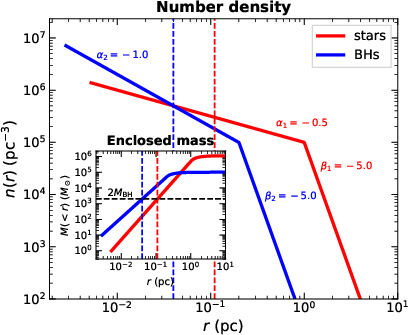
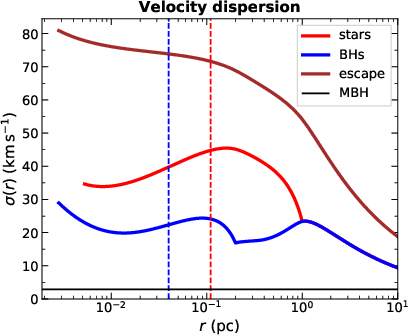
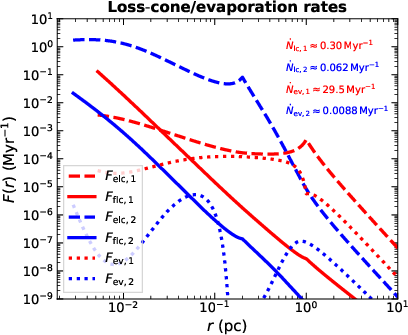
Figure 1: Radial profiles of number densities, enclosed masses, velocity dispersions, and loss-cone/evaporation fluxes for stars and stellar-mass BHs in a prototypical NSC.
Dynamical Evolution and SMBH Growth
The time evolution of the NSC is governed by coupled differential equations for the stellar and BH populations, their break radii, and the central SMBH mass. The SMBH grows via three channels:
- Tidal Disruption Events (TDEs): Stars are disrupted when their pericenter falls within the tidal radius.
- Captured EMRIs: Stellar-mass BHs are captured via gravitational wave emission during close encounters.
- Gas Accretion: Episodic inflows from the surrounding gas reservoir, capped at a specified Eddington ratio.
The model tracks the rates of evaporation, loss-cone feeding, and binary formation (2-body and 3-body channels). Simulations are performed for both typical and extreme NSC initial conditions, with and without gas inflow episodes.
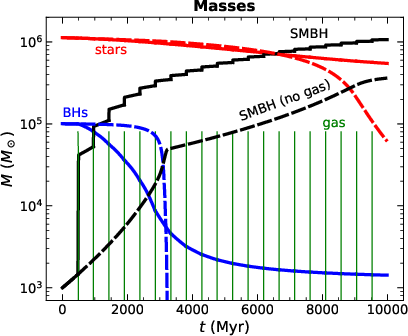
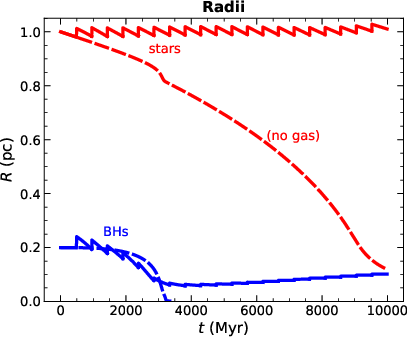
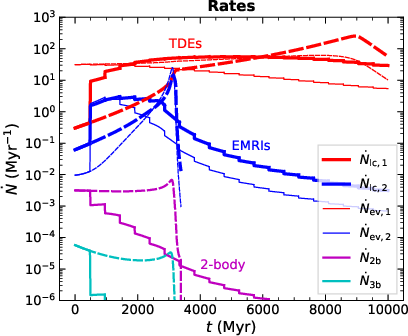
Figure 2: Time evolution of stellar and BH masses, break radii, and event rates for a typical NSC, comparing dry and gas-rich scenarios.
Results: SMBH Assembly and Transient Rates
For typical NSCs (∼106M⊙), the SMBH grows to ∼3×105M⊙ over several Gyr via TDEs and EMRIs, with gas inflows boosting the final mass to >106M⊙. In denser, more massive NSCs (∼108M⊙), the SMBH rapidly reaches ∼107M⊙ within ∼100 Myr, with ∼80% of the mass assembled via TDEs and EMRIs. The duty cycle of TDEs increases with SMBH mass and gas inflow rate.
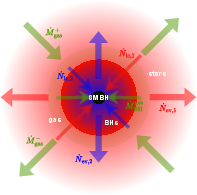
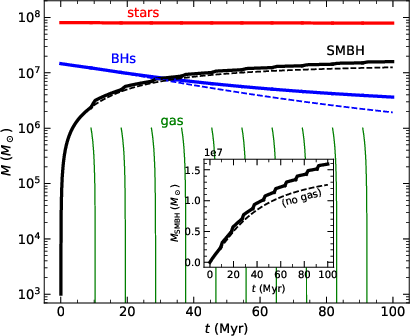
Figure 3: Schematic of the NSC model, showing the spatial distribution of stars, stellar-mass BHs, gas, and the central SMBH, with inflow/outflow channels.
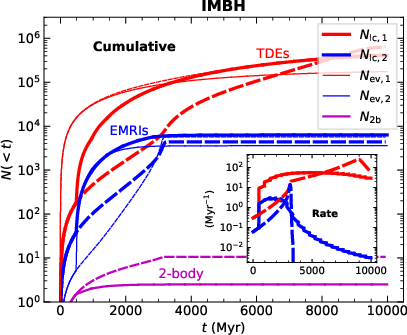
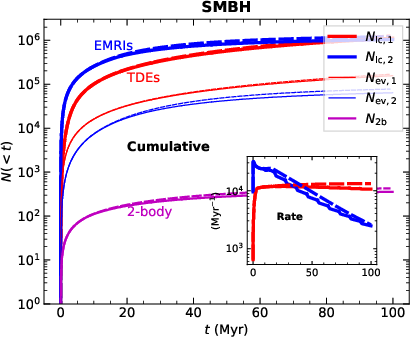
Figure 4: Cumulative numbers of TDEs, captured EMRIs, and 2-body binaries for typical and extreme NSC scenarios.
The predicted volumetric TDE rate at z=4--$6$ is RTDE∼0.003yr−1Gpc−3 (median), with a ratio RTDE/REMRI∼10. Integrated over the comoving volume, this yields ∼40 TDEs and a few EMRIs per observer year. These rates are lower bounds due to selection effects and uncertainties in NSC properties.
X-ray Weakness of LRDs
Despite phases of super-Eddington accretion, LRDs are observed to be X-ray weak. The model attributes this to geometric and radiative effects: hard X-rays from the SMBH corona are scattered in the funnel walls of a thick accretion disk ("Polish doughnut" configuration), analogous to the ultrasoft state of Cygnus X-3. This leads to strong beaming and polarization, with X-rays escaping only at oblique angles, explaining the lack of direct X-ray detection.
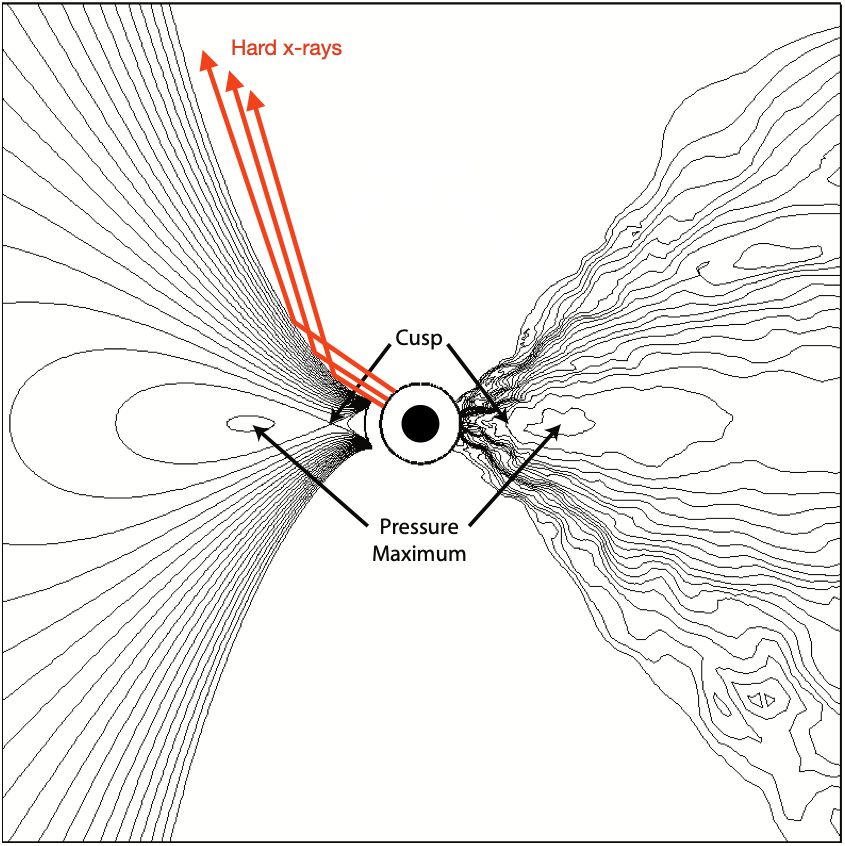
Figure 5: Hard X-rays from the BH corona scattered on funnel walls in a thick accretion disk, suppressing direct X-ray emission.
Implications and Future Directions
The results support the scenario where LRDs are the sites of early SMBH growth, with dense NSCs providing the necessary environment for rapid assembly via TDEs, EMRIs, and gas accretion. The model predicts correlated rates of multimessenger transients, with TDEs dominating over EMRIs. Residual populations of stellar-mass BHs enable ongoing high-energy phenomena, including micro-TDEs and BH-BH mergers.
The low X-ray luminosity of LRDs is naturally explained by accretion disk geometry and radiative transfer effects. Future observations (e.g., LISA, UVEX, JWST) will test these predictions, particularly the EMRI background and high-redshift TDE candidates.
Conclusion
This work provides a comprehensive semi-analytical model for SMBH growth in high-redshift NSCs, integrating stellar dynamics, gas physics, and transient event rates. The framework robustly explains the observed properties of LRDs, including their abundance, rapid SMBH assembly, and X-ray weakness. The results have significant implications for the formation of SMBHs in the early universe and the expected rates of multimessenger transients, guiding future observational and theoretical studies.










